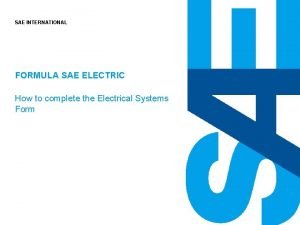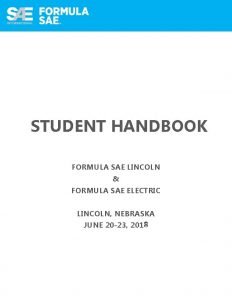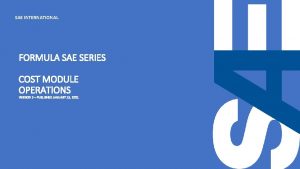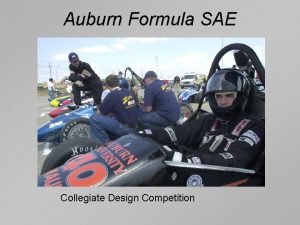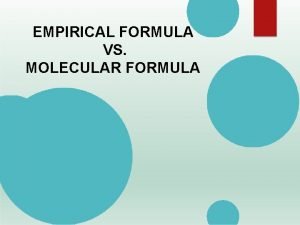SAE INTERNATIONAL FORMULA SAE ELECTRIC How to complete







- Slides: 7

SAE INTERNATIONAL FORMULA SAE ELECTRIC How to complete the Electrical Systems Form

Overview Electrical System Form is a design document for the tractive system of the vehicle. Purpose • Provide feedback to teams early in the design process when it is easier to fix the problem. • Enforce a design process for the tractive system. THE ESF is NOT… o A collection of all data sheets you can find for your parts o A complete collection of theoretical electrical engineering Reviewers are Engineers with significant experience in HV electrical systems for vehicles. SAE INTERNATIONAL

Format of the document • First Section • Provides a high level overview of the tractive system • Provide a simplified schematic of the TS to give the reviewer a reference of the architecture of your TS. • Subsequent Sections • Go into detail for each component/subsystem in the vehicle. • • Provide the requested information in each section and complete the tables provided. Where pictures/CAD are requested provide appropriate pictures so the reviewer can see the device question in context of components around it / vehicle. SAE INTERNATIONAL

Keys to a Successful ESF • Start Early • Learn to use Microsoft Word • Keep with next • References • Get support from both electrical and mechanical team members • CAD Tools • Provide CAD model images of components in car. • Provide readable accurate schematics The reviewer will be considering your design with respect to the rules for the competition. SAE INTERNATIONAL

Guidance • Remember that the reviewer isn’t going to be familiar with special component names/nicknames your team uses. Be sure to define these in the document. • Write at the correct level. You don’t need to describe Ohm’s law. • Schematics • Make sure part numbers and symbols on schematic are correct • Pspice is great for modeling your circuit, maybe not the best for creating an ESF schematic. • It is not obvious that Voltage source V 1 is your sensor, or probe 3 is the output. • Be sure to include/cover all required points in schematics requested. • If a requested areas cannot be clearly shown in a single schematic use additional schematics to show the details and improve overall readability. SAE INTERNATIONAL

Common Mistakes • Not enough information in the document. • Not completing all the sections of the document. • If you can’t complete most of the document, you are behind in the design process, and in jeopardy of not completing the vehicle in time. Use this deadline as an opportunity to get back on track. • Forgetting fuses on low current TS components like the IMD. • Watch out for the voltage ratings of all components in the TS (wire, fuses, connectors, …) • Failure to include CAD of student designed PCB’s with TS circuits (and a scale for the reviewer to determine important measurements. SAE INTERNATIONAL

Automatic Rejection criteria • Large portions of the document are incomplete • Template modified (incorrect section numbers) SAE INTERNATIONAL
